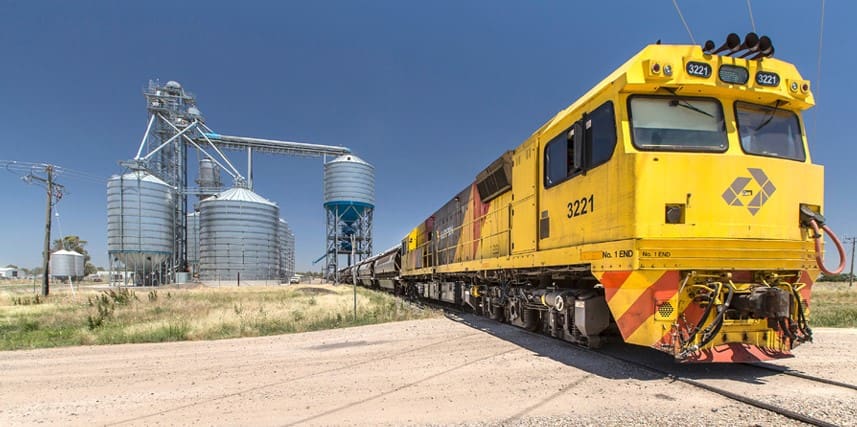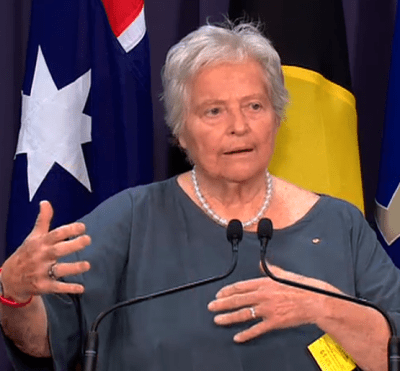
A grain train loads at Narrabri in northern NSW.
THE NEW South Wales Government has accepted the recommendations of a freight network review released on Friday that includes proposals to assess the state’s grain rail lines, with a view to closing those that are rarely or no longer in use.
The report, Delivering Freight Policy Reform in NSW, was compiled by an independent panel appointed by the transport minister and included Inland Rail review author Kerry Schott, Australian Logistics Council chief executive Hermione Parsons, and Lucio Di Bartolomeo, chair of Health Infrastructure NSW and Australian Naval Infrastructure.
The report investigated issues across the NSW freight network, from road, rail and port infrastructure, funding, and management to strategic planning and data collection and management.
It addressed concerns raised by industry members and submissions on the grain rail network, rail access, and the management of the Country Rail Network (CRN).
The report is the final stage of a multi-consultation process which has allowed stakeholders to submit feedback on an initial discussion paper and a draft report.
The findings doubled down on those featured in the draft report that there should be a review of the NSW rail network “with a view to consolidate and close disused rail lines to target funding to the remaining priority networks”.
As a medium-term action to commence within two years, the report recommended the government “work with the grain industry to close rarely used grain lines” with any savings “allocated to upgrades of rail and road networks that benefit the grain industry”.
The grain lines are part of the CRN, which is managed under contract from Transport for NSW by UGL Regional Linx, one of three rail-network managers in the state.
The draft findings recommended the government work towards reducing the number of network operators to two over the long term, identifying the CRN as a key candidate for reform.
However, the final report softened the language, calling for an investigation into “all long-term options for operating the CRN with the aim of moving to the model that best delivers a fully coordinated rail network, the highest possible service levels and value for money”.
The management of the CRN has been the subject of complaints from submitters and stakeholders during the review process.
NSW Minister for Transport John Graham thanked the panel for the report and reiterated the importance of the freight network to the state.
“The NSW Government is determined to enable the freight sector to reach its potential, which could mean adding a further $131.5 billion year to the state’s economy and employing more than half a million people by 2061,” Mr Graham said.
“Freight arrives at our biggest ports but moves through all our neighbourhoods on the road and rail network.
“Preparing those networks for the drivers of change to freight – especially population growth and technological change – is a big task and this report sets a roadmap to guide us.”
NSW Farmers response
The report has drawn criticism from state agricultural body, NSW Farmers, for advocacating the closure of dedicated grain rail lines.
NSW Farmers president Xavier Martin said this would result in more grain being transported on roads.
“Efficient, connected freight rail networks are what farmers need to get food and fibre off farm and into market at a fair price – but if this report is actioned, we could well see rail lines closed, forcing more freight trucks on the road, at higher cost to us all,” Mr Martin said.
“Using more trucks for freight will mean more traffic, more hazards and more damage on roads that are already in ruins thanks to a series of natural disasters, and a healthy dose of neglect.
“What we need is regional rail lines, in the right place, in the right condition, all across NSW and the broader nation.”
This view was also reflected in several submissions received into the Interim Directions report released in September last year, with stakeholders referring to the variable nature of grain production as a reason to keep lines active.

Kerry Schott
“Given the unpredictable nature of regional weather patterns and variable volumes of grain harvests, we suggest that the closure of grain lines should be treated cautiously, to ensure that there is adequate understanding of data and the root cause underpinning why grain lines may not have been used in recent years,” private rail freight company Pacific National said in its submission.
Pacific National called for “a more strategic approach” aimed at maintaining “grain rail lines at a consistent baseline of readiness that can be raised to full operational status reasonably quickly”.
Similarly, advocacy group Lachlan Regional Transport Committee said considerations for closing a grain line needed to extend to why the line was disused or underutilised by local growers.
“Utilisation of railways also begs the question as to why some silos on branch lines attract less grain,” the LRTC submission said.
“Part of the explanation could lie in the cost of train operations and regulations compared with road.”
The organisation also pointed to disused lines which it believes had sufficient local interest to be made viable, such as the Blayney-Demondrille line or the Narrandera-Tocumwal line.
System-wide optimisation
The panel addressed these concerns during an information session held after the release of the draft findings on October 2.
Mr Di Bartolomeo said it was not the panel’s intention for growers “to take their grain further to its end destination…and no one is suggesting that it should be the case”.
“What we are finding though is that we have a very variable harvest these days and we understand that export is, generally speaking, after the domestic market has been met,” Mr Di Bartolomeo said.
“The other dimension that has changed that I have seen is the on-farm storage.
“We aren’t suggesting that any branch line should close if it fairly regularly receives grain, but if it’s not receiving grain and only receives grain maybe every few years, it’s a pointless exercise to spend money on those grain lines.
“I’d rather see money spent on roads where in fact that grain is currently going to.
“It just doesn’t make sense that we’re spending money on a part of the network that isn’t being used and then we have other parts of the network…that we are under-spending on.”
Report lead Ms Schott said the grains industry should not take these recommendations as a slight against the sector or the importance of the rail network to the grain-freight task.
“We’re not suggesting spending less money on the transport of grain at all; we’re just suggesting optimising the use of the two networks so it’s much more efficient and they get more bang for their buck,” Ms Schott said.
“If there was savings, we’d probably join you in arguing that that should go to farmers.”
Consultation promised
In a statement provided to Grain Central, a spokesperson for Transport for NSW said implementation of the recommendations would “commence in line with the timeframes outlined in the report”.
They said any changes to the freight network would be precipitated by extensive and targeted consultation.
“The medium-term action identified to undertake a review of the NSW rail network, with consideration given to consolidate and close disused rail lines, is one of a number of actions to target funding to the remaining priority networks and optimise the end-to-end grain network and freight system,” the spokesperson said.
“This will require extensive consultation with the grain industry and other stakeholders.”
Grain Central: Get our free news straight to your inbox – Click here

I have worked a lifetime on saving our rail line, looking to upgrade with heavy duty rail & 100t wagons. The failure of governments to keep bulk commodities on rail & protect people, as well as our roads, with the transfer of costs to ratepayers. The Tottenham to Bogan Gate line has been used for over 100 years. My great grandfather found the Mount Royal copper mine in Tottenham in 1906, also The Caroline mine & rail was used to cart the ore. There has been very little vision since, the people of this era were visionaries. Protect our rail & the grain will flow for a century, protecting our people.
Regards Terry Fishpool
Chair of Tottenham-Bogan Gate Action Committee.
In recess but not forgotten.